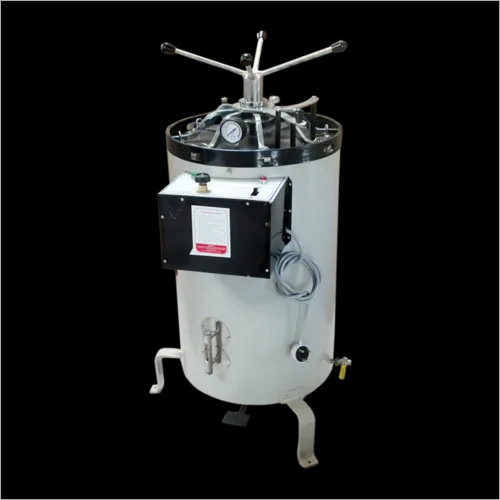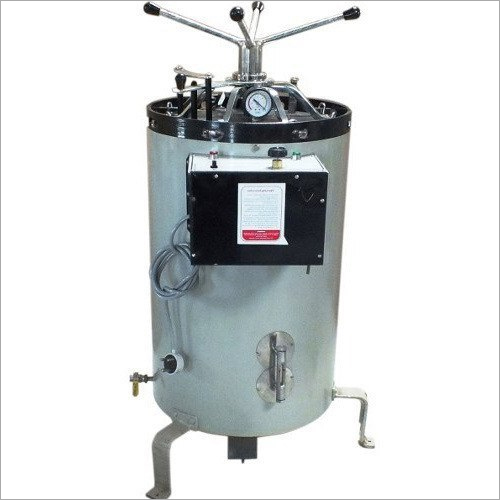Cylindrical Autoclave
Price 325000 INR/ Piece
Cylindrical Autoclave Specification
- Type
- Horizontal Cylindrical Autoclave
- Chamber Size
- 600 liters
- Chamber Thickness
- 8 mm
- Outer Size
- 740 mm x 1700 mm
- Compressed Air
- 4-6 kg/cm
- Door Type
- Radial Locking, Manual Sliding
- Design Pressure
- 2.5 bar
- Working Pressure
- 1.2 bar
- Design Temperature
- 140C
- Heat Uniform
- 1C throughout chamber
- Insulation
- High-density Mineral Wool
- Net Weight
- Approx. 650 kg
- Recording Parameters
- Digital, Temp & Pressure
- Spraying Mode
- Rotary Nozzle, 360 coverage
- Outer Trolley
- Provided, SS 304 Material
- Inner Trolley
- Provided, SS 304 Material
- Spraying Piping
- SS 304, Corrosion-resistant
- Steam
- External Source, 4-7 kg/cm
- Sterilizing Temperature
- 121C 134C
- Working Temperature
- 121C
- Sterilization Time
- 30-60 minutes adjustable
- Temperature Scope
- Up to 134C
- Piping System
- SS 304, Seamless
- Valves
- Safety, Vacuum Breaker, Release Valves
- Power Consumption
- 6-12 kW (Depending on model)
Cylindrical Autoclave Trade Information
- Minimum Order Quantity
- 1 , , Piece
- Supply Ability
- 2 Pieces Per Week
- Delivery Time
- 2-3 Week
About Cylindrical Autoclave
Specification
| Chamber Volume | 110 litre |
| Usage/Application | Laboratory |
| Brand | Krishna |
| Warranty | 1 Year |
| Power Consumption | 9 KW |
| Shape | Horizontal |
| Capacity | 110 litre |
| Insulation Wall | Triple Wall |
| Automation Grade | Semi Automatic |
- Instrument name : Horizontal Cylindrical Autoclave
- Make : Krishna
- Construction : Triple wall
- Inner chamber : Made of SS 304 grade Stainless steel
- Outer body : Stainless steel
- Door : Stainless steel
- Working pressure : 15 20 Psi
- Maximum Pressure : 30 Psi
- Hydraulic tested pressure : 45 Psi
- Pressure control : Automatic by pressure control switch
- Door type : Radial lock type
- Door lock : Automatic by safety device
- Accessories : Water level indicator, Vaccum breaker, Temperature gauge, Steam trap
- Structure : Mild Steel
- Steam boiler : At the bottom of instrument
- Load : 9 KV
Advanced Control & Automation
The autoclave utilizes a microprocessor-based programmable PLC control with an intuitive LED/LCD digital display, allowing users to manage sterilization cycles with precision. Multiple cycle modespre-vacuum, gravity, drying, and sterilizationcan be selected to match specific application requirements effortlessly.
Premium Construction & Safety
Constructed from corrosion-resistant stainless steel 316/304, the chamber and all critical piping ensure enhanced longevity and easy maintenance. Safety is integral, with features like automatic pressure and temperature cut-off, door interlock mechanisms, and robust radial locking and manual sliding door configurations.
Efficient Sterilization for Professional Applications
Designed for demanding environments, this autoclave provides a consistent temperature scope up to 134C and adjustable sterilization times between 30-60 minutes. The rotary nozzle spraying system delivers 360 coverage, ensuring uniform sterilization for large or complex loads in hospitals, laboratories, and pharmaceutical manufacturing.
FAQs of Cylindrical Autoclave:
Q: How does the cylindrical autoclave ensure uniform sterilization throughout the chamber?
A: The autoclave uses a rotary nozzle spraying system with 360 coverage and high-density insulation, maintaining a consistent temperature of 1C throughout the chamber to guarantee thorough sterilization of all items.Q: What materials are used for the chamber and piping system, and why are they important?
A: The chamber is made of mirror-polished stainless steel 316/304, and the piping uses seamless SS 304. These materials provide outstanding corrosion resistance, durability, and easy cleaning, which are critical for long-term, hygienic use in medical and laboratory settings.Q: When should I use different sterilization cycles such as pre-vacuum, gravity, or drying?
A: Pre-vacuum cycles are ideal for porous loads and instruments, gravity cycles suit solid items and liquids, while the drying mode is best after sterilization to ensure moisture-free instruments. The microprocessor-based PLC control lets you select modes specific to your loads requirements.Q: Where can this autoclave be installed, and what are the required facility connections?
A: This floor-mounted autoclave is designed for installation in hospitals, laboratories, and pharmaceutical environments. It requires a 220-240V AC, 3-phase electrical connection, an external steam source (4-7 kg/cm), and a compressed air supply (4-6 kg/cm).Q: What are the benefits of the fully automatic drain system with condensate recovery?
A: The fully automatic drain system enhances operational efficiency by automatically removing condensate and recovering it, reducing water waste, minimizing manual intervention, and ensuring stable environmental conditions within the chamber.Q: How does the safety system protect users during operation?
A: Safety features like automatic pressure and temperature cut-off, door interlock, and multiple safety and vacuum breaker valves prevent accidental opening, overpressure, or overheating, ensuring a secure sterilization process for operators.

Price:
- 50
- 100
- 200
- 250
- 500
- 1000+
More Products in Laboratory Autoclave Category
Vertical Autoclave
Price 65000 INR / Piece
Minimum Order Quantity : 2 Pieces
Voltage : 220 Volt (v)
Material : Inner Stainless Steel: Outer Mild Steel with paint coated
Usage : Sterilization
Net Weight : 75 Kilograms (kg)
Vertical Autoclave
Price 89000 INR / Piece
Minimum Order Quantity : 1 Piece
Voltage : 220 Volt (v)
Material : Inner Stainless Steel: Outer Mild Steel with paint coated
Usage : Sterilization
Net Weight : 90 Kilograms (kg)
SS Vertical Autoclave
Price 3000.00 INR / Piece
Minimum Order Quantity : 1 , , Piece
Voltage : 240 Volt (v)
Material : SS
Usage : Industrial
Aluminium Portable Autoclave
Price 3000.00 INR / Piece
Minimum Order Quantity : 1 , , Piece
Voltage : 240 Volt (v)
Material : SS
Usage : Industrial

 Send Inquiry
Send Inquiry






 Send Inquiry
Send Inquiry Send SMS
Send SMS